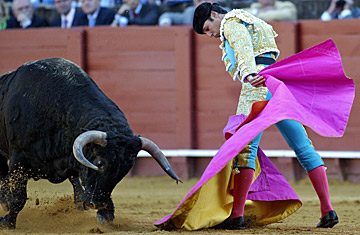
Spanish matador Francisco Rivera Ordóñez performs a pass to the bull during a bullfight in the Maestranza Bullring in Seville
Outsiders may debate whether bullfighting is sport or art, but within the normally close circle of Spanish aficionados, there is only one correct answer, and it has nothing to do with basketball. Yet if bullfighting is an art, does that make all its practitioners artists?
Most definitely not, has been the answer of many bullfighting insiders ever since Spanish Culture Minister César Antonio Molina announced on Feb. 27 that this year's prestigious Fine Arts medal for bullfighting would go to Francisco Rivera Ordóñez. The 35-year-old matador has killed more than 2,000 bulls, but because of both his family ties — he descends from Spain's most important bullfighting dynasty and was briefly married to the Duchess of Alba's daughter — and his abundant good looks, Rivera is as well-known for his presence in the gossip rags as for his work with the cape and sword. (See pictures of bullfighting.)
And that may be precisely the problem. Announcing the award, Molina described Rivera's technique as "now more aesthetic, relaxed and profound." But "aesthetic" is not exactly how many in the bullfighting world see Rivera's efforts. "I think we're all in agreement that he doesn't represent the artistic side of the toreo," says Israel Vicente, director of Tauropress, a public-relations company that specializes in bullfighting. "He's been given the prize because he's a name that people recognize, not because he's an artist."
Vicente isn't alone in that characterization. Upon hearing of the award, bullfighter José Antonio Morente de la Puebla told the press, "I think it's shameful that they would give it to him," and added that he saw the decision as clear evidence of how little those behind the prize understood "about bullfighting and about art."
Two well-respected bullfighters, Paco Camino and José Tomás, went so far as to return their medals (granted in 2004 and 2008, respectively) in protest. According to Vicente, whose agency represents Tomás, the decision was motivated by the latter's "belief that he is a depository for the art of bullfighting, that he has to defend it. José Tomás has nothing against Rivera; he has a problem with the ministry's argument for bestowing the medal on Rivera. It devalues the award."
Rivera is an easy target. The eldest son of Paquirri, a popular matador who was killed in 1984 by a foul-tempered bull named Avispado, he is the grandson of Antonio Ordóñez and the grandnephew of Luis Miguel Dominguín (the two men's rivalry was famously depicted by Ernest Hemingway in The Longest Summer). Rivera and his equally dashing brother Cayetano, also a bullfighter, have modeled for Armani, hawked high-end watches, appeared in the pages of Vogue and been featured on the American news program 60 Minutes. They have also tended toward prominent matches — Francisco was married to Eugenia Martínez de Irujo, daughter of Spain's most titled aristocrat, while Cayetano was wed to Blanca Romero, a model and actress. Both men are currently dating former Miss Spains. (Read TIME's top 10 beauty pageant scandals.)
"Francisco is wealthy, he's young, he's handsome, he's a good businessman, he's famous, and he's the last in the line of a bullfighting aristocracy that is utterly unique," says a close family friend. "It's normal that he would be attacked. What is not normal is that two respected figures like Camino and José Tomás would do something so disrespectful. I don't think it's jealousy that motivates them; I think it's arrogance."
Even those who are unhappy with Rivera's award seem to believe that Tomás and Camino have gone too far. Writing in El País, bullfighting critic Antonio Lorca said, "The decision of these two maestros isn't very elegant. This idea that 'the award was correct when they gave it to me, but not so much now' doesn't speak well of their sense of collegiality." Carlos Javier Trejo, a bullfighting critic based in Seville, agrees. "I think José Tomás had a little flare-up of vanity, like a Hollywood actor who returns an Oscar because he doesn't like the person who wins it the year after him. But it's very unfortunate, because it hurts bullfighting as a whole," Trejo says.
Of course, bullfighting was hardly undamaged even before this latest episode. In 2004, Barcelona approved a nonbinding resolution declaring itself an "antibullfighting city," prompting nearly 40 other cities and towns in Catalonia to follow suit; in 2007 the state-run Spanish Television networks stopped broadcasting bullfights live. A 2006 Gallup poll found that 72% of Spaniards said they were "not interested" in what is still commonly referred to as the "national fiesta."
Tomás' triumphant 2007 return to the ring, following a five-year hiatus, was seen by many aficionados as a way of stanching the decline. In his first fight back, Tomás sold out "antibullfighting" Barcelona's 20,000-seat ring. But even his powers aren't unlimited, say critics. "Who is he to decide what is worthy and what isn't?" asks the Rivera family friend. "Art is in the eye of the beholder."
